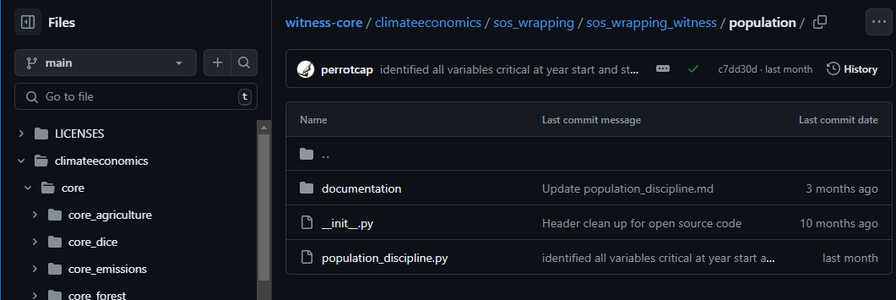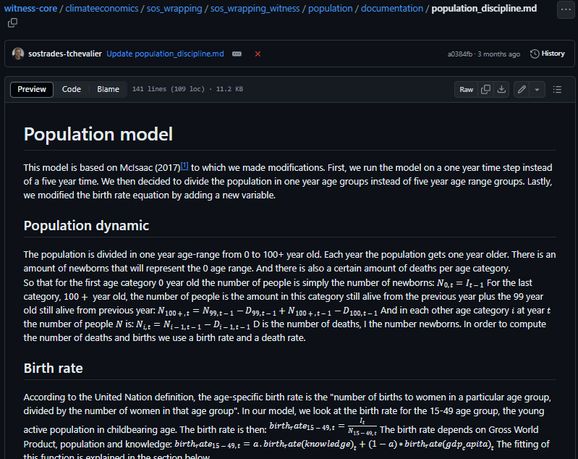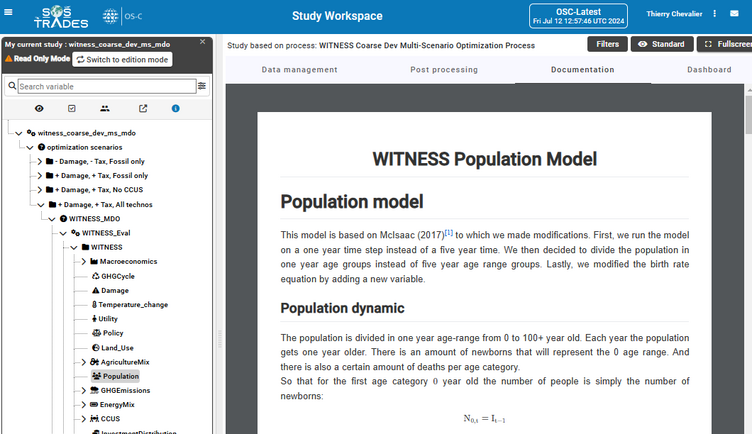Snapshot of - WITNESS
Archive of WITNESS, version: 2.0
Reference card - WITNESS
The reference card is a clearly defined description of model features. The numerous options have been organized into a limited amount of default and model specific (non default) options. In addition some features are described by a short clarifying text.
Legend:
- not implemented
- implemented
- implemented (not default option)
About
Name and version
WITNESS 2.0
Institution
Open-Source for Climate (OS-C), N/A, https://os-climate.org/transition-analysis/., Linux Foundation (LF), N/A, https://www.linuxfoundation.org/.
Documentation
WITNESS documentation consists of a referencecard and detailed model documentation
Process state
published
Model scope and methods
Model documentation: Model scope and methods - WITNESS
Model type
- Integrated assessment model
- Energy system model
- CGE
- CBA-integrated assessment model
Geographical scope
- Global
- Regional
Objective
IAM framework enabling simulation, multi-domain analysis or optimization involving all or part of Economy, Energy, Resources, Climate, Population, Public policies. A typical usage is to optimize over years economy investment across available energy production technologies to maximize produced energy while minimizing emissions within resources constraints (or globally to maximize welfare under constraints).
Solution concept
- Partial equilibrium (price elastic demand)
- Partial equilibrium (fixed demand)
- General equilibrium (closed economy)
- Systems dynamics based approach
Solution horizon
- Recursive dynamic (myopic)
- Intertemporal optimization (foresight)
Solution method
- Simulation
- Optimization
- Simulation-based optimization
Note: Advanced applied mathematics for multi-disciplinary analysis and optimization of complex system of systems applied to IAM scope
Temporal dimension
Base year:2020, time steps:yearly, horizon: user defined (typically now to 2100 )
Note: yearly timestep for convenient alignment with datasets, but numerically any timestep could be choosen
Spatial dimension
Number of regions:Global
Note: Regionalization in progress (high level regionalization with 5-10 macro-regions expected for end'23, smart spatial multi-scaling by end'24)
Time discounting type
- Discount rate exogenous
- Discount rate endogenous
Policies
- Emission tax
- Emission pricing
- Cap and trade
- Fuel taxes
- Fuel subsidies
- Feed-in-tariff
- Portfolio standard
- Capacity targets
- Emission standards
- Energy efficiency standards
- Agricultural producer subsidies
- Agricultural consumer subsidies
- Land protection
- Pricing carbon stocks
- Renewable energy subsidies
Socio-economic drivers
Model documentation: Socio-economic drivers - WITNESS
Population
- Yes (exogenous)
- Yes (endogenous)
Population age structure
- Yes (exogenous)
- Yes (endogenous)
Education level
- Yes (exogenous)
- Yes (endogenous)
Urbanization rate
- Yes (exogenous)
- Yes (endogenous)
GDP
- Yes (exogenous)
- Yes (endogenous)
Income distribution
- Yes (exogenous)
- Yes (endogenous)
Employment rate
- Yes (exogenous)
- Yes (endogenous)
Labor productivity
- Yes (exogenous)
- Yes (endogenous)
Total factor productivity
- Yes (exogenous)
- Yes (endogenous)
Autonomous energy efficiency improvements
- Yes (exogenous)
- Yes (endogenous)
Other socio economic driver
- Behavioural change
Macro-economy
Model documentation: Macro-economy - WITNESS
Economic sector
Industry
- Yes (physical)
- Yes (economic)
- Yes (physical & economic)
Energy
- Yes (physical)
- Yes (economic)
- Yes (physical & economic)
Transportation
- Yes (physical)
- Yes (economic)
- Yes (physical & economic)
Residential and commercial
- Yes (physical)
- Yes (economic)
- Yes (physical & economic)
Agriculture
- Yes (physical)
- Yes (economic)
- Yes (physical & economic)
Forestry
- Yes (physical)
- Yes (economic)
- Yes (physical & economic)
Macro-economy
Trade
- Coal
- Oil
- Gas
- Uranium
- Electricity
- Bioenergy crops
- Food crops
- Capital
- Emissions permits
- Non-energy goods
Cost measures
- GDP loss
- Welfare loss
- Consumption loss
- Area under MAC
- Energy system cost mark-up
Categorization by group
- Income
- Urban - rural
- Technology adoption
- Age
- Gender
- Education level
- Household size
Institutional and political factors
- Early retirement of capital allowed
- Interest rates differentiated by country/region
- Regional risk factors included
- Technology costs differentiated by country/region
- Technological change differentiated by country/region
- Behavioural change differentiated by country/region
- Constraints on cross country financial transfers
Resource use
Coal
- Yes (fixed)
- Yes (supply curve)
- Yes (process model)
Conventional Oil
- Yes (fixed)
- Yes (supply curve)
- Yes (process model)
Unconventional Oil
- Yes (fixed)
- Yes (supply curve)
- Yes (process model)
Conventional Gas
- Yes (fixed)
- Yes (supply curve)
- Yes (process model)
Unconventional Gas
- Yes (fixed)
- Yes (supply curve)
- Yes (process model)
Uranium
- Yes (fixed)
- Yes (supply curve)
- Yes (process model)
Bioenergy
- Yes (fixed)
- Yes (supply curve)
- Yes (process model)
Water
- Yes (fixed)
- Yes (supply curve)
- Yes (process model)
Raw Materials
- Yes (fixed)
- Yes (supply curve)
- Yes (process model)
Land
- Yes (fixed)
- Yes (supply curve)
- Yes (process model)
Other resource use
- Copper
Technological change
Energy conversion technologies
- No technological change
- Exogenous technological change
- Endogenous technological change
Energy End-use
- No technological change
- Exogenous technological change
- Endogenous technological change
Material Use
- No technological change
- Exogenous technological change
- Endogenous technological change
Agriculture (tc)
- No technological change
- Exogenous technological change
- Endogenous technological change
Energy
Model documentation: Energy - WITNESS
Energy technology substitution
Energy technology choice
- No discrete technology choices
- Logit choice model
- Production function
- Linear choice (lowest cost)
- Lowest cost with adjustment penalties
Energy technology substitutability
- Mostly high substitutability
- Mostly low substitutability
- Mixed high and low substitutability
- Discrete technology choices with mostly high substitutability in some sectors and mostly low substitutability in other sectors
Energy technology deployment
- Expansion and decline constraints
- System integration constraints
Energy
Electricity technologies
- Coal w/o CCS
- Coal w/ CCS
- Gas w/o CCS
- Gas w/ CCS
- Oil w/o CCS
- Oil w/ CCS
- Bioenergy w/o CCS
- Bioenergy w/ CCS
- Geothermal power
- Nuclear power
- Solar power
- Solar power-central PV
- Solar power-distributed PV
- Solar power-CSP
- Wind power
- Wind power-onshore
- Wind power-offshore
- Hydroelectric power
- Ocean power
Hydrogen production
- Coal to hydrogen w/o CCS
- Coal to hydrogen w/ CCS
- Natural gas to hydrogen w/o CCS
- Natural gas to hydrogen w/ CCS
- Oil to hydrogen w/o CCS
- Oil to hydrogen w/ CCS
- Biomass to hydrogen w/o CCS
- Biomass to hydrogen w/ CCS
- Nuclear thermochemical hydrogen
- Solar thermochemical hydrogen
- Electrolysis
- Plasma cracking
- Electrolysis SOEC
- Electrolysis PEM
- Eletrolysis AWE
- WaterGasShift
Refined liquids
- Coal to liquids w/o CCS
- Coal to liquids w/ CCS
- Gas to liquids w/o CCS
- Gas to liquids w/ CCS
- Bioliquids w/o CCS
- Bioliquids w/ CCS
- Oil refining
- FisherTropsch
- HefaDecarboxydation
- HefaDeoxygenation
- Transesterification
Refined gases
- Coal to gas w/o CCS
- Coal to gas w/ CCS
- Oil to gas w/o CCS
- Oil to gas w/ CCS
- Biomass to gas w/o CCS
- Biomass to gas w/ CCS
- AnaerobicDigestion
- SteamMethaneReforming
- Pyrolisis
- AutothermalReforming
- CoElectrolysis
Heat generation
- Coal heat
- Natural gas heat
- Oil heat
- Biomass heat
- Geothermal heat
- Solarthermal heat
- CHP (coupled heat and power)
- FossilGas
- Pelletizing
- ManagedWood
- UnmanagedWood
- CropEnergy
Grid Infra Structure
Electricity
- Yes (aggregate)
- Yes (spatially explicit)
Gas
- Yes (aggregate)
- Yes (spatially explicit)
Heat
- Yes (aggregate)
- Yes (spatially explicit)
CO2
- Yes (aggregate)
- Yes (spatially explicit)
Hydrogen
- Yes (aggregate)
- Yes (spatially explicit)
Energy end-use technologies
Passenger transportation
- Passenger trains
- Buses
- Light Duty Vehicles (LDVs)
- Electric LDVs
- Hydrogen LDVs
- Hybrid LDVs
- Gasoline LDVs
- Diesel LDVs
- Passenger aircrafts
Freight transportation
- Freight trains
- Heavy duty vehicles
- Freight aircrafts
- Freight ships
Industry
- Steel production
- Aluminium production
- Cement production
- Petrochemical production
- Paper production
- Plastics production
- Pulp production
Residential and commercial
- Space heating
- Space cooling
- Cooking
- Refrigeration
- Washing
- Lighting
Land-use
Model documentation: Land-use - WITNESS
Land cover
- Cropland
- Cropland irrigated
- Cropland food crops
- Cropland feed crops
- Cropland energy crops
- Forest
- Managed forest
- Natural forest
- Pasture
- Shrubland
- Built-up area
- SolarThermal
- SolarPV
Agriculture and forestry demands
- Agriculture food
- Agriculture food crops
- Agriculture food livestock
- Agriculture feed
- Agriculture feed crops
- Agriculture feed livestock
- Agriculture non-food
- Agriculture non-food crops
- Agriculture non-food livestock
- Agriculture bioenergy
- Agriculture residues
- Forest industrial roundwood
- Forest fuelwood
- Forest residues
Agricultural commodities
- Wheat
- Rice
- Other coarse grains
- Oilseeds
- Sugar crops
- Ruminant meat
- Non-ruminant meat and eggs
- Dairy products
- Eggs
- Fruits & vegetables
- White meat
- Potatoes
Emission, climate and impacts
Model documentation: Emissions - WITNESS, Climate - WITNESS, Non-climate sustainability dimension - WITNESS
Greenhouse gases
- CO2 fossil fuels
- CO2 cement
- CO2 land use
- CH4 energy
- CH4 land use
- CH4 other
- N2O energy
- N2O land use
- N2O other
- CFCs
- HFCs
- SF6
- PFCs
Pollutants
- CO energy
- CO land use
- CO other
- NOx energy
- NOx land use
- NOx other
- VOC energy
- VOC land use
- VOC other
- SO2 energy
- SO2 land use
- SO2 other
- BC energy
- BC land use
- BC other
- OC energy
- OC land use
- OC other
- NH3 energy
- NH3 land use
- NH3 other
Climate indicators
- Concentration: CO2
- Concentration: CH4
- Concentration: N2O
- Concentration: Kyoto gases
- Radiative forcing: CO2
- Radiative forcing: CH4
- Radiative forcing: N2O
- Radiative forcing: F-gases
- Radiative forcing: Kyoto gases
- Radiative forcing: aerosols
- Radiative forcing: land albedo
- Radiative forcing: AN3A
- Radiative forcing: total
- Temperature change
- Sea level rise
- Ocean acidification
Carbon dioxide removal
- Bioenergy with CCS
- Reforestation
- Afforestation
- Soil carbon enhancement
- Direct air capture
- Enhanced weathering
- CalciumLooping
- ChilledAmmoniac
- CO2Membranes
- MonoEthanolAmine
- Piperazine
- PressureSwingAdsorbtion
- AmineScrubbing
- CalciumPotassiumScrubbing
- BiomassBryingFossilization
- DeepOceanInjection
- DeepSalineFormation
- DepletedOilGas
- EnhancedOilRecovery
- GeologicMineralization
- PureCarbonSolidStorage
Climate change impacts
- Agriculture
- Energy supply
- Energy demand
- Economic output
- Built capital
- Inequality
- Utility/Welfare
Co-Linkages
- Energy security: Fossil fuel imports & exports (region)
- Energy access: Household energy consumption
- Air pollution & health: Source-based aerosol emissions
- Air pollution & health: Health impacts of air Pollution
- Food access
- Water availability
- Biodiversity
Model Documentation - WITNESS
Model presentation
WITNESS is an open source Integrated Assessment Model software framework - which means it's can be used as an application ready to use as is, or a toolset you can use, complete, customize or overload.
It can be used to explore potential future pathways for greenhouse gas emissions under different policy scenarios, assess how different levels of global warming will affect natural and human systems, identify the most cost-effective strategies producing energy while reducing emissions, analyze how to transition from fossil fuels to renewable energy sources while ensuring energy security and economic stability, evaluate the potential impacts of specific climate policies (e.g., carbon pricing or renewable energy incentives impact on emissions or economic growth), determine the role of emerging technologies such as carbon capture and storage or advanced nuclear in achieving climate goals…
Its cooperative study setup and analysis capabilities also allow WITNESS to enhance cooperation to achieve global climate targets within a group of "coopetitors".
WITNESS is built on a powerful open source cooperative simulation platform called SoSTrades, and uses multi-disciplinary analysis and optimization (MDAO) library called GEMSEO.
This leading edge simulation base allow using the framework to set up and solve a large range of problems, be it in the pure IAM ecosystem area or deriving IAM scenarios/results for various applications such as evaluation of physical risks, optimization of ecosystem energy migration, or assets portfolio valuation…
The initial motivations to code "Yet Another IAM", a were - in that order :
- to properly take into account energy-macroeconomy coupling, which was very well highlighted as problematic in current scenarios in a document from Carbon4, and well synthetized in the World GDP vs World energy production diagram it contains showing how most IAM predictions represent a sudden and abrupt change from decades of correlation between these 2 quantities.
- to properly add and couple an endogenous population model. Population is exogeneous in most models whereas climate impact on population and increase of pandemic rates with pressure on land could have significant economic impact- as demonstrated by impact of SARS-CoV-1, or measured productivity losses during recent heatwaves
- to build an open and cooperative basis for a modular IAM that would be easy to extend and scale, thanks to re-using in the IAM area the leading edge complex system of systems simulation techniques that initial authors were experts at using in aerospace sector (including but not limited to MBSE and MDAO) - with the ability to reliably manage very large amount of models and automating handling of interactions and feedback loops and avoid the simulation constraints hampering modeling intend.
We decided to develop a Stock Flow Coherent model, as it seems they are the only models that succeeds in back-testing evaluations (cf "Les modèles IAMs et leurs limites" A.Grandjean 2024).
The global structure of WITNESS is often presented using this picture (Water not well implemented yet despite shown here) :
but the detailed coupling structure is depending of the problem you solve, coupling being handled automatically.
As an example, here is a map of a typical WITNESS full couplings.
You can find some videos of live presentations of WITNESS model are available on witness4climate.org website.
Reference documentation
WITNESS reference documentation is located directly in the source GitHub repositories, in a "documentation" folder next to the source code for each discipline.
Let's for example, consider the population model folder in GitHub:
The documentation markup file can be displayed directly in the tool in the "Documentation tab" for each discipline:
and will also be available in the tool in the "Documentation" tab for the discipline:
References and links to academic papers / reference dataset used are listed at the end of these disciplines documentation pages.
Installation documentation
Installation documentation for standalone laptop installation can be found here.
Local classical installation or as a Docker component is available for Linux, Mac and Windows.
For a full cloud installation with DevSecOps of models, please contact the project here :-)
Developer's documentation
A draft developer's documentation is available here.
User and developer's MOOC are planned to be developed and will be hosted by Linux Foundation.
Support
Support sessions are organised for users ("Come as you are" sessions) and for developers ("Code as you are" sessions).
Please check here for next sessions and registration.




Note: Complex system of systems simulation approach with all systems fully coupled